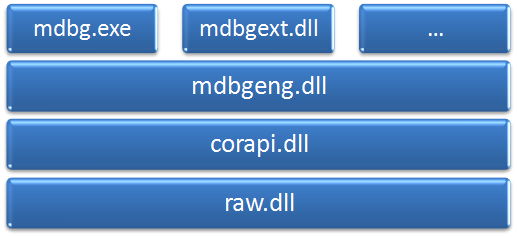Since I’m guessing most of my readers have never build a debugger before (I certainly hadn’t), let’s start with the debugger equivalent of Hello, World!
import clr clr.AddReference('CorDebug') import sys from System.Reflection import Assembly from System.Threading import AutoResetEvent from Microsoft.Samples.Debugging.CorDebug import CorDebugger ipy = Assembly.GetEntryAssembly().Location py_file = sys.argv[1] cmd_line = ""%s" -D "%s"" % (ipy, py_file) evt = AutoResetEvent(False) def OnCreateAppDomain(s,e): print "OnCreateAppDomain", e.AppDomain.Name e.AppDomain.Attach() def OnProcessExit(s,e): print "OnProcessExit" evt.Set() debugger = CorDebugger(CorDebugger.GetDefaultDebuggerVersion()) process = debugger.CreateProcess(ipy, cmd_line) process.OnCreateAppDomain += OnCreateAppDomain process.OnProcessExit += OnProcessExit process.Continue(False) evt.WaitOne()
I start by adding a reference to the CorDebug library I discussed at the end of my last post (that’s the low level managed debugger API plus the C# definitions of the various COM APIs). Then I need both the path to the IPy executable as well as the script to be run, which is passed in on the command line (sys.argv). For now, I just use Reflection to find the path to the current ipy.exe and use that. I use those to build a command line – you’ll notice I’m adding the –D on the command line to generate debugger symbols.
Next, I define two event handlers: OnCreateAppDomain and OnProcessExit. When the AppDomain is created, the debugger needs to explicitly attach to it. When the process exits, we signal an AutoResetEvent to indicate our program can exit.
Then it’s a simple process of creating the CorDebugger object, creating a process, setting up the process event handlers and then running the process via the call to Continue. We then wait on the AutoResetEvent for the debugged process to exit. And voila, you have the worlds simplest debugger in about 30 lines of code.
To run it, you run the ipy.exe interpreter and pass in the ipydbg script above and the python script to be debugged. You also have to pass –X:MTA on the command line, as the ICorDebug objects only work from a multi-threaded apartment. When you run it, you get something that looks like this:
» ipy -X:MTA ipydbg.py simpletest.py
OnCreateAppDomain DefaultDomain
35
OnProcessExit
Simpletest.py is a very simple script that prints the results of adding two numbers together. Here, you see the event handlers fire by writing text out to the console.
For those of you who’d like to see this code actually run on your machine, I’ve created an ipydbg project up on GitHub. The tree version that goes with this blog post is here. If you’re not running Git, you can download a tar or zip of the project via the “download” button at the top of the page. It includes both the CorDebug source as well as the ipydbg.py file (shown above) and the simpletest.py file. It also has a compiled version of CorDebug.dll, so you don’t have to compile it yourself (for those IPy only coders who don’t have VS on their machine).

